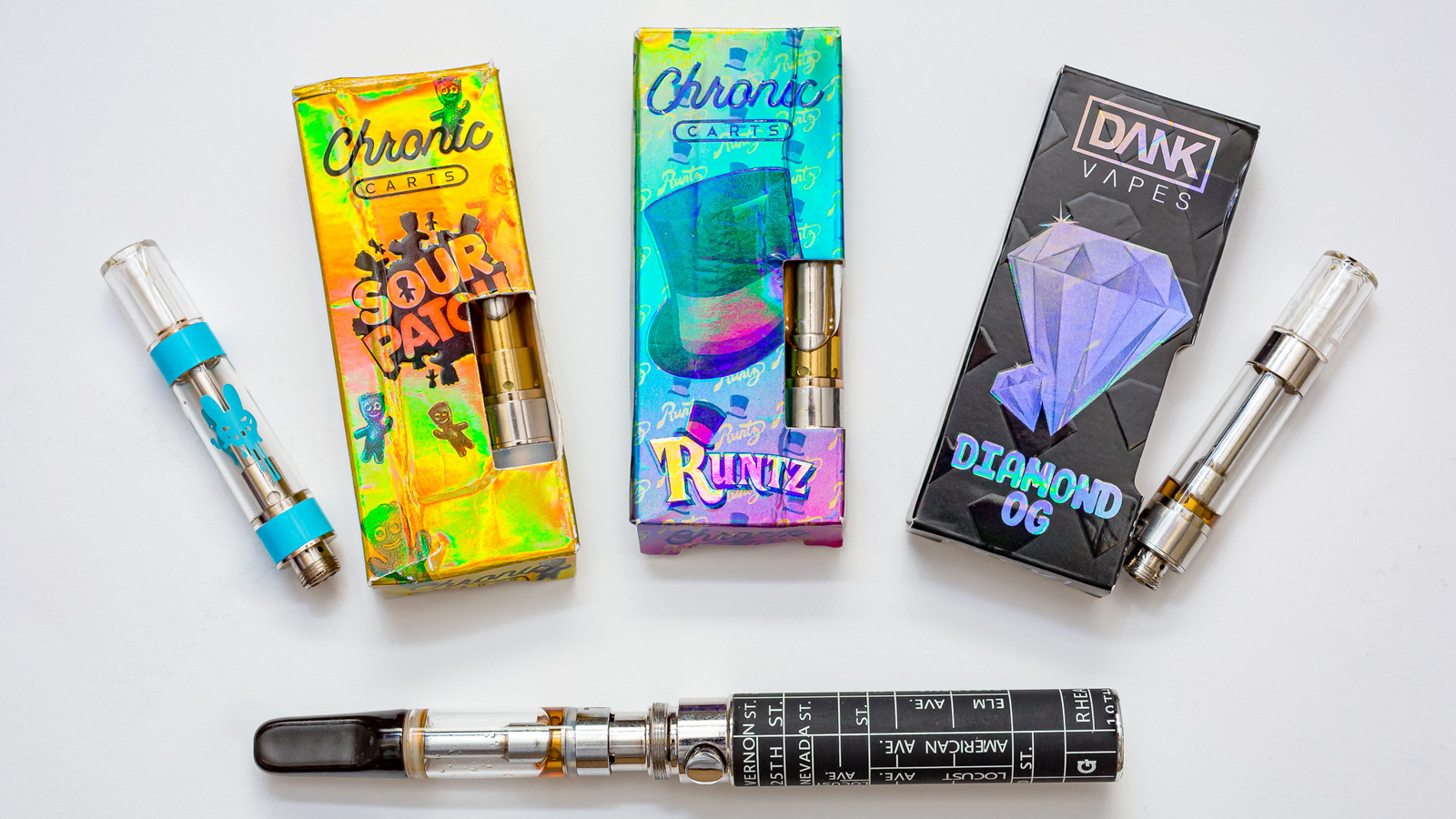
By WeedMaps News' Tyler Koslow, provided exclusively to Benzinga Cannabis.
As a result of the 380 illnesses and six deaths of people across the United States from vaping cannabis or e-cigarettes, consumers, vape makers, and retailers alike have to be aware of how products are made and where they were made.
There have been serious health and safety concerns associated with vaping technology, in the e-cigarette and the cannabis industry. About 380 confirmed and probable cases of severe respiratory problems were reported in 36 states after patients were vaping nicotine or cannabis, The Associated Press reported on Sept. 13, 2019. Of these cases, six patients died.
This public health situation has forced popular cannabis companies into action to protect customers by devising ways to verify authentic products and thwart potentially hazardous counterfeits.

Vape pens have gained acceptance from the cannabis community for their ease of use. Since vaping technology is so new, long-term health effects of vaping aren't yet known. (Gina Coleman/Weedmaps)
Vape pens have gained acceptance from the cannabis community for their ease of use. Since vaping technology is so new, long-term health effects of vaping aren't yet known. (Photo by Gina Coleman/Weedmaps)Trendy as they may be, vape pen cartridges are still the new kid on the cannabis block. This recent emergence, akin to the rise of e-cigarettes, has researchers scrambling to find out the long-term health effects of vaporization. Meanwhile, many states which have legalized cannabis are still refining testing requirements. The lack of insight into vaping has left many cannabis consumers to wonder whether their vape cartridge is safe to consume.
What's Inside Your Vape Cartridge?
While there are plenty of vaporizers that can be used to consume flower and concentrates, the most popular device style to emerge from the vape clouds is the portable penlike design. Vape pens are designed to vaporize cannabis oils and distillates.
A vape pen comprises two primary components: a battery and the vape cartridge. The battery consists of the bottom portion of the vape pen, providing power to the heating element, which vaporizes the cannabis oil contained inside the vape cartridge. Most vape oil producers will tell you which voltage is compatible with the selected cartridge. These devices come in many shapes, sizes, and styles. Some vape pens have a button that activates the vape cartridge, while others are buttonless and only activated once the user takes a draw.
Vape cartridges include a mouthpiece, chamber, and heating element known as an atomizer. The chamber is filled with concentrated amounts of cannabinoids, usually either THC- or CBD-dominant, and terpenes. The atomizer is activated when contact is initiated with the battery, heating up the chamber and vaporizing the cannabis oil.

The chamber of a vape cartridge is filled with a THC- or cannabidiol (CBD)-dominant concentrate, and some producers will reintroduce terpenes that had been removed from the distillation process. (Gina Coleman/Weedmaps)
Cannabis vape oils that fill vape cartridges are usually created through a process called distillation, which strips the cannabis molecules down to just the cannabinoids. So, what about unique flavors that are defined by the plant's terpene profile found in the aroma of fresh cannabis flower? All of that is stripped away during the distillation process. Some cannabis oil producers will collect the cannabis-derived terpenes during the process and reintroduce them into the oil, allowing the distillate-filled cartridge to be strain-specific. More commonly, the terpenes used to flavor distillate are derived from other natural plants.
Are There Contaminants in Your Vape Cartridge and Pens?
The most prevalent problem on the illegal vape market are concentrate cartridges that contain high levels of pesticides. When consumed at concentrated levels, inhaled pesticides cause health problems. To ensure that vape cartridges don't contain hazardous pesticide level, it's important to purchase from reputable brands that disclose third-party test results and include screening for pesticides.
Cutting agents can be added to enhance the intensity of the vapor cloud and overall mouthfeel of the vapors. Common cutting agents that are sometimes infused with cannabis oil and e-cigarette vape juice include:
- Polyethylene glycol (PEG): a cutting agent used in vape liquids to keep the product evenly mixed.
- Propylene glycol (PG): a binding agent that is added to cannabis vape cartridges because of its ability to foster even vape draws.
- Vegetable glycerin (VG): Added to vape liquids to help generate large vape clouds for the user.
- Vitamin E acetate: A generally safe additive for food, but it's been found in thickening agents in illicit THC cartridges in some of the reported illnesses. Vitamin E acetate is a different chemical than the vitamin E found naturally in foods and in supplements. Vitamin E is safe to consume as a food or supplement up to 1,000 milligrams daily.
Although the Food and Drug Administration (FDA) has labeled these cutting agents as safe for human ingestion, questions remain about what happens when these compounds are inhaled. A 2010 study, published in the International Journal of Environmental Research and Public Health, found that inhaling PG could potentially exacerbate asthma and allergies. Additional research also suggests that, when vaporized at high temperatures, both PEG and PG breaks down into the carcinogens formaldehyde and acetaldehyde.
There is a steadily rising number of cannabis oil producers that insist on not adding any cutting agents to their product. If you're concerned about the potential harm of these cutting agents, seek out raw products that only contain cannabis distillate and cannabis-derived terpenes.

These vapes were identified by the New York State Department of Health as part of 34 cases of severe pulmonary illnesses in the state, among 380 confirmed and probable cases, with six patients dying, throughout the U.S. Health officials are looking into vitamin E acetate and its link to the illnesses. (Photo by New York State Department of Health via Flickr)
It's not just the cannabis oil that is at risk of contamination. In a 2018 study conducted by scientists at Johns Hopkins Bloomberg School of Public Health in Baltimore, researchers discovered that unsafe amounts of toxic metals, including lead, were leaking from the heating coils of e-cigarettes and seeping into the aerosol that was inhaled. As the FDA continues to grapple with how to properly regulate e-cigarettes and vape pens, it's up to vape cartridge manufacturers and testing labs to catch potentially hazardous products.
“Metal concentrations in the e-liquid from the original dispenser increased markedly in the same e-liquid after it was added to the device and was brought into contact with the heating coil, both in the generated aerosol and in the liquid that remained in the tank,” the study stated. “These findings support the hypothesis that metals are transferred from the device (most likely the coil) to the e-liquid and from the e-liquid to the aerosol that is inhaled by the user.”
A large portion of vape cartridge components are produced at metal foundries in China, many of which add small amounts of lead into brass and copper feedstocks to improve the malleability of metals. This includes the heating coil, which heats up the cannabis oil, potentially transferring toxic metals into the consumer's vapors.
As lab testing requirements have been bolstered in California, scientists have been able to identify vape cartridges that contain high levels of lead before they reach the legal market. The California Bureau of Cannabis Control implemented Phase 3 testing standards on Jan. 1, 2019, which included analytical testing for heavy metals.
How to Tell if Your Vape Cartridge is Legit or Counterfeit
Another consequence of the vape pen's rising popularity is the steady stream of fake THC cartridges that have flooded the market. Some of the industry's most recognizable brands, such as Connected Cannabis Co., Heavy Hitters and Kingpen, have battled against counterfeit vape cartridges. These counterfeit cartridges are being sold with similar branding, logos, and packaging as some of these producers, making it difficult for the average consumer to tell whether they're buying legitimate products.
The potential dangers of consuming oil from a counterfeit vape cartridge are pretty straightforward. For starters, it's nearly impossible to tell what's inside of the oil without getting it lab tested. Since these counterfeits are likely bypassing state testing regulations, there's no way of telling, without proper laboratory testing, if there are cutting agents, contaminants, or even actual cannabis-derived oil in the cartridge.
Many cannabis oil manufacturers have been proactive in helping consumers identify whether they have purchased a legitimate vape cartridge. For instance, Heavy Hitters, the California-based cannabis vape cartridge producer, has shared a list of authorized retailers on its website, and also have an online form where customers can report counterfeits. Kingpen, another vape cartridge producer in California, has used its social media presence to raise awareness and campaign against counterfeits.
In legal states and provinces, the best way to thwart the counterfeit vape cartridge epidemic is to purchase products from reputable retailers or dispensaries. Unfortunately, this isn't a viable option for cannabis consumers living in areas where recreational cannabis is still illegal. Still, there are certain precautions one could take to reduce the chances of purchasing a counterfeit vape cartridge.
When ordering or browsing cannabis products on Weedmaps, for instance, you can limit your search results to only display Weedmaps Verified products. This feature will show storefronts and delivery services have been authorized to sell vape cartridges from reputable industry brands. Also, read reviews from the Weedmaps community regarding the retailer and its products before purchasing.
If the price of a branded cartridge is significantly below market price, that could be a red flag. Avoid purchasing cartridges that are sold without any packaging. If you have a vape cartridge that you suspect might be counterfeit, go to the manufacturer's website and compare your cartridge with legitimate products. There could be a serial number, QR code, or certain stylistic differences that will help you decipher whether you have a real cartridge. Additionally, a quick Google search about a specific brand should unearth a number of resources that will distinguish real vape cartridges from counterfeits.
Feature image: Devices for vaping cannabis and e-cigarettes may have contributed to 380 confirmed and probable respiratory illnesses in 36 states, public health officials have warned. Some of the devices may have been illegally made or sold. (Gina Coleman/Weedmaps)
This article was originally published on Weedmaps News and it was updated in the midst of an outbreak of lung illnesses associated with e-cigarette and illicit THC and cannabidiol (CBD) cartridges. The article has been updated to include crucial information on the ongoing investigations.






